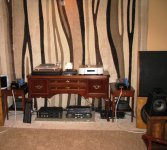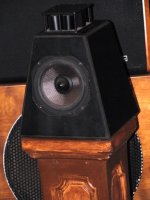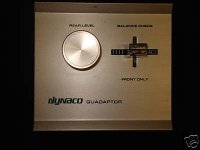No interest in uniform distribution of lows and highs in an OMNI? I thought that was crucial 😕.what's good in uniform reponse in the sagittal plane for a flooder type speaker? I can't see the point
I think it doesn't matter at all
No interest in uniform distribution of lows and highs in an OMNI? I thought that was crucial 😕.
it IS laterally but NOT sagittally, at least not in case of a flooder where interaction with floor and ceiling is unusual
uniform distribution at all angles of lows and highs is not an end in itself
what is crucial is characteristics of reflections and total power response in room
Last edited:
But uniform response at all thinkable listening positions is a fundamental requirement to call something an OMNI speaker.uniform distribution at all angles of lows and highs is not an end in itself
A uniform (total) power response in room is useless if there is no uniform direct response. You simply can't talk of a realistic reproduction, if you have not even gotten the direct response right.what is crucial is characteristics of reflections and total power response in room
But uniform response at all thinkable listening positions is a fundamental requirement to call something an OMNI speaker.
measurement mic position or listening positions? 😉 because these are two very different things
plus we already know that what can be called an OMNI is a question of definition so no point in debating over words
A uniform (total) power response in room is useless if there is no uniform direct response. You simply can't talk of a realistic reproduction, if you have not even gotten the direct response right.
well, truth is that no listener can ever hear anything like direct response!
direct response is a myth, another measurement artifact
BTW what do You mean by uniform direct response? uniform in what sense?
Last edited:
Graaffff...it's in any earing physiology text with some variations following the authors (15 to 30 ms). Two different signals are blended if perceived in this fork, hence alterations of the tonality and of the space. The most difficult parameter to integrate in playback music is that it's a continuous flow, very different from the sine tests used in most of laboratories. Looks like the timing starts on a transient on witch the earing process locks on. For the sake of the discussion, we can assimilate this to a kind of Hass effect...
Correct-o-mundo (American slang for "you are correct". Perhaps used by others as well). Check out this speaker - which I got to listen to this past weekend for several hours at the Nashville Audio Society meet. I'm not trying to push these speakers down anyone's throat - simply agreeing with your statement.
According to their manufacturer (High Emotion Audio) Pyra Bella 7 - Products - High Emotion Audio these speakers have been used in studies at Vanderbilt (a medical university) and Belmont (a music university) in studies about acoustic neural response primarily due to the very fast response of the tweeter.
But guess what? They also happen to be omni drivers. Annnnnnd are being used in some of the local recording studios. Of course Nashville being the home base and recording haven (hmmmm heaven) for many Country and Western artist I'm not sure if that is a positive endorsement for many of you.
Me? I'm a fan of omni - and use my omni speakers often. Buuuut I also have some Fostex 167 full rangers and have owned many flavors of "box" speakers in the past - so I DO know the difference and what I prefer to listen to given my desires at the time. I'm also a fan of Country and Western - so that there juz goes ta show ya - 😀😀😀
Attachments
Last edited:
According to their manufacturer (High Emotion Audio) Pyra Bella 7 - Products - High Emotion Audio these speakers have been used in studies at Vanderbilt (a medical university) and Belmont (a music university) in studies about acoustic neural response primarily due to the very fast response of the tweeter.
*Gasssp...Wheeeeze....."Luke, I am your father..." *wheeze*
Sorry, I couldn't help it.
*Gasssp...Wheeeeze....."Luke, I am your father..." *wheeze*
Sorry, I couldn't help it.
Oh - no need to worry about that. I totally understand -
Take it up with Scott Wilkinson
http://www.ultimateavmag.com/ultimate-tech/let_there_be_let/
Last edited:
A: Hey look! What a beautiful flower over there.
B: What? You stupid, that's a wrong flower. Oh, that's not even a flower. Go check your sight, or brain, or both....
B: What? You stupid, that's a wrong flower. Oh, that's not even a flower. Go check your sight, or brain, or both....
Have you been drinking Red Bull and watching Gene Wilder movies????
Actually - on 2nd thought - Woody Allen?
Actually - on 2nd thought - Woody Allen?
If I am not missing something, these speakers are not omni (360° 20 to 20000). The tweeter must be bi/dipolar, and the boomer mono.
But as you have been there, how do they sound ? Are their claims justificated ?
But as you have been there, how do they sound ? Are their claims justificated ?
One interesting way to recreate a spacious sound in an average listening room is to place a third speaker behind the listening position, wired from the two stereo + (positive) connections, one + to each of the third speakers terminals.
This results in only L/R difference information coming from the "phantom" speaker.
My educated (?) guess is that a single additional speaker won't be enough. One basic requirement for added realism is reflections arriving from the frontal hemisphere at around 60°.
Originally Posted by weltersys:
One interesting way to recreate a spacious sound in an average listening room is to place a third speaker behind the listening position, wired from the two stereo + (positive) connections, one + to each of the third speakers terminals.
This results in only L/R difference information coming from the "phantom" speaker.
Having listened using a single phantom speaker extensively, I can attest the triangle of left, right, and a single rear speaker gives a very spacious sound. It works well regardless of speaker to wall spacing, and works well in small or large scale application, I use it on my boat and have used it with a 7500 watt quad amp PA set in a 50 foot equilateral triangle set up.
The stereo difference information, which gives a sense of space, is enhanced (exaggerated) by the discreet rear location.
The spaciousness of the phantom speaker set up certainly sounds "bigger" than the room reflections from an omni speaker.
That said, "added realism" seems an oxymoron to me, whatever the angle it arrives from.
Art
One interesting way to recreate a spacious sound in an average listening room is to place a third speaker behind the listening position, wired from the two stereo + (positive) connections, one + to each of the third speakers terminals.
This results in only L/R difference information coming from the "phantom" speaker.
Rather than guess, you could take a piece of speaker wire, any old speaker, and give it a try. Unless access to speaker terminals is obstructed, takes about the time of a pop song to hook up.My educated (?) guess is that a single additional speaker won't be enough. One basic requirement for added realism is reflections arriving from the frontal hemisphere at around 60°.
Having listened using a single phantom speaker extensively, I can attest the triangle of left, right, and a single rear speaker gives a very spacious sound. It works well regardless of speaker to wall spacing, and works well in small or large scale application, I use it on my boat and have used it with a 7500 watt quad amp PA set in a 50 foot equilateral triangle set up.
The stereo difference information, which gives a sense of space, is enhanced (exaggerated) by the discreet rear location.
The spaciousness of the phantom speaker set up certainly sounds "bigger" than the room reflections from an omni speaker.
That said, "added realism" seems an oxymoron to me, whatever the angle it arrives from.
Art
Last edited:
If I am not missing something, these speakers are not omni (360° 20 to 20000). The tweeter must be bi/dipolar, and the boomer mono.
But as you have been there, how do they sound ? Are their claims justificated ?
The tweeter is dipole and there is a passive radiator on the rear of the speaker that matches the 6.5 inch driver.
These were crossed over with stereo sub-woofers @ 80 Hz.
A very nice speaker - one of the best I have listened to. vertical dispersion is limited - I would guess about 20 or 30 degrees - so placement at ear level height is important.
The tweeters are very efficient so lots of dynamics.
One interesting way to recreate a spacious sound in an average listening room is to place a third speaker behind the listening position, wired from the two stereo + (positive) connections, one + to each of the third speakers terminals.
This results in only L/R difference information coming from the "phantom" speaker.
Dynaquad! I think this method was even described in The Whole Earth Catalog.
Dynaquad! I think this method was even described in The Whole Earth Catalog.
The device that inspired my name!
Attachments
Dynaquad! I think this method was even described in The Whole Earth Catalog.
Jez - can you even get that mag anymore? I think the last one I had was from around 1970......
Rather than guess, you could take a piece of speaker wire, any old speaker, and give it a try. Unless access to speaker terminals is obstructed, takes about the time of a pop song to hook up.
Having listened using a single phantom speaker extensively, I can attest the triangle of left, right, and a single rear speaker gives a very spacious sound. [...]
That said, "added realism" seems an oxymoron to me, whatever the angle it arrives from.
Art,
I'm not guessing what the setup you did describe sounds like because I did listen to it. We are certainly talking about very different sensations. The Hafler setup creates just a spatial effect whereas reflections from the frontal hemisphere add realism. What you hear becomes real and believable although the soundstage might be much wider than the room is. It has something to do with how our brain processes auditory information.
Last edited:
Added reflections don't add "realism" to my ears, they add things I hear as "comb filtering" and "time smear" and "reverb" that were not recorded in the original.Art,
I'm not guessing what the setup you did describe sounds like because I did listen to it. We are certainly talking about very different sensations. The Hafler setup creates just a spatial effect whereas reflections from the frontal hemisphere add realism. What you hear becomes real and believable although the soundstage might be much wider than the room is. It has something to do with how our brain processes auditory information.
I know that using acoustic "clouds" to suppress early reflections in my studio control room reduces those problems without making the room overly dead.
Since I do much of my critical listening outdoors (live sound) my perception of what added reflections do may be quite different from what yours is.
To each his own version of reality :^).
Art
they add things I hear as "comb filtering"
Comb filtering is also an issue with narrow beam speakers. Each ear gets sound from two speakers.
- Home
- Loudspeakers
- Multi-Way
- Why are OMNI speakers not more popular?


